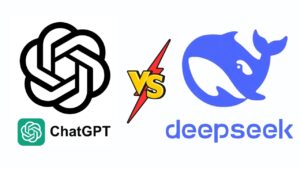DeepSeek-V3 vs. ChatGPT: Which AI Language Model is Right for You?
Introduction
In the rapidly evolving world of artificial intelligence, language models have become indispensable tools for businesses, developers, and everyday users. From generating creative content to providing customer support, AI models like DeepSeek-V3 and ChatGPT are transforming how we interact with technology. But with so many options available, how do you choose the right one for your needs?
In this blog, we’ll dive into a detailed comparison of DeepSeek-V3 and ChatGPT, two leading AI language models. Whether you’re a business owner, a developer, or simply an AI enthusiast, this comparison will help you understand the strengths, weaknesses, and unique features of each model. By the end, you’ll have a clearer idea of which AI is best suited for your specific use case.
DeepSeek-V3 vs. ChatGPT: A Side-by-Side Comparison
Here’s a detailed comparison of the two models:
| Feature | DeepSeek-V3 | ChatGPT |
|---|---|---|
| Developer | DeepSeek (Chinese company) | OpenAI |
| Primary Focus | Optimized for Chinese language tasks and regional adaptability | General-purpose AI with a global focus |
| Language Proficiency | Excels in Chinese; supports multilingual tasks | Strong in English and widely spoken languages; supports multiple languages |
| Training Data | Likely includes a significant portion of Chinese-language data | Diverse, global dataset with a focus on English content |
| Use Cases | Tailored for Chinese businesses, education, and regional applications | Versatile: content creation, customer support, coding, education, etc. |
| Strengths | – Efficient in Chinese language tasks – Cost-effective – Regional focus |
– High versatility – Creative text generation – Large user base |
| Weaknesses | – May lack global versatility – Limited creative flair in non-Chinese tasks |
– Can be verbose or generic – May struggle with highly regional contexts |
| Customization | Offers customization for specific industries or regions | Highly customizable via fine-tuning and API integrations |
| Integration | APIs and tools for Chinese market applications | Widely integrated into global platforms and tools |
| Response Quality | Accurate and context-aware, especially for Chinese queries | Coherent and creative, but can sometimes be overly verbose |
| Ethical Considerations | Adheres to ethical guidelines with a focus on Chinese regulatory standards | Follows OpenAI’s ethical guidelines; actively works to reduce bias |
| User Experience | Smooth and efficient for Chinese users; may vary for non-Chinese tasks | Intuitive and user-friendly; widely adopted globally |
| Availability | Primarily available in China and select regions | Globally accessible |
| Cost | Likely cost-effective for Chinese businesses | Freemium model (free tier + paid subscription for advanced features) |
Conclusion
Both DeepSeek-V3 and ChatGPT are powerful AI language models, but they cater to slightly different audiences and use cases. If you’re looking for a model that excels in Chinese language tasks and is tailored for regional applications, DeepSeek-V3 might be the better choice. On the other hand, if you need a versatile, globally adaptable AI for a wide range of tasks—from creative writing to technical problem-solving—ChatGPT is likely the way to go.
Ultimately, the decision comes down to your specific needs. Are you targeting a Chinese-speaking audience or operating in a region where DeepSeek-V3 is more optimized? Or do you need a globally recognized AI with a track record of versatility and creativity? Whichever you choose, both models represent the cutting edge of AI technology and are sure to enhance your productivity and innovation.
Call to Action
What’s your take on these two AI models? Have you used either DeepSeek-V3 or ChatGPT? Share your experiences in the comments below! And if you found this comparison helpful, don’t forget to share this blog with others who might be deciding between these two powerful tools.

